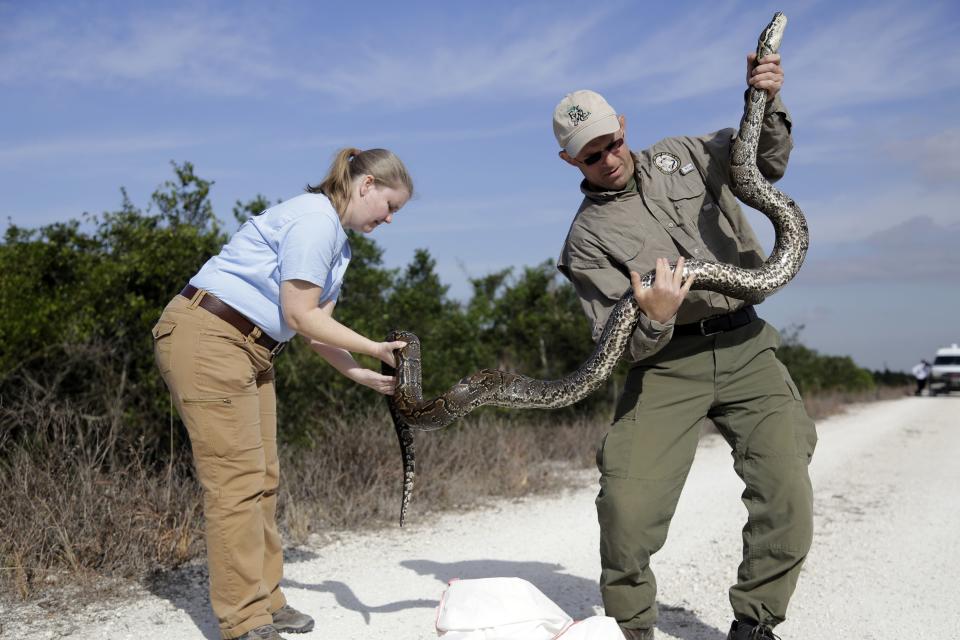A sneaky snake: Teams hunt for rock pythons in Everglades
http://news.yahoo.com/sneaky-snake-t...202428381.html


MIAMI (AP) — For all the danger posed to Florida's Everglades by invasive Burmese pythons, there's one thing researchers don't want to know: how they would interact with another python species that threatens to move into the same territory.
The Florida Fish and Wildlife Conservation Commission is racing to keep northern African pythons, also known as rock pythons, from slithering into the Everglades. So far, just a few dozen rock pythons have been found in suburban Miami, not in the wild wetlands where their Burmese cousins thrive in large numbers.
That's still enough to scare wildlife officials into hiring a specialist over the last year to patrol weekly for rock pythons in the hopes of eradicating them before they join the other invasive species threatening restoration efforts in the Everglades.
TWO SNAKE SPECIES:
Both snakes are non-venomous and can grow to 20 feet long in their native habitats. Wildlife officials say rock pythons captured here have averaged 10 feet in length; the longest Burmese python caught in Florida was over 18 feet long. Each has a splotchy, black-and-tan pattern, though the Burmese pythons' markings are more defined and resemble the spots of a giraffe. There's no good population estimate for either species, wildlife officials say, but it's generally believed that tens of thousands of Burmese pythons live in the Everglades. Both snake populations likely originated from pets that either escaped or were illegally dumped by their owners.
Last year, 141 Burmese pythons were removed from 1.5 million-acre Everglades National Park. Since 2001, about 30 rock pythons have been removed from a 6-square-mile suburban area west of Miami. Last year, officials found just one rock python, which was run over by a state Department of Transportation lawn mower in August. "Just like Burmese pythons, we know they're very hard to find. We know it's going to take a lot of surveys of finding none before we're able to say that we were successful," said Jenny Ketterlin Eckles, a wildlife commission biologist.
UNNATURAL HABITAT:
So far, the rock pythons' range is limited to the suburbs where marshlands are divided by a highway, canals, strip malls and housing developments crowded with new homes. They've been captured in canals and in open areas next to homes; some end up as road kill. One fatal dog attack by a rock python was confirmed in 2013.
On Thursday, wildlife officials timed a monthly survey to coincide with cooler temperatures that drive cold-blooded snakes seeking warmth to bask in open, sunny areas like roads and levees. The wildlife commission also left fliers about the snakes on mailboxes in one neighborhood. Anyone who encounters either python species is encouraged to contact Miami-Dade Fire Rescue.
WHAT'S AT STAKE:
Biologists spent Thursday morning slowly scanning grasses winding through spindly skeletons of melaleuca trees that have been poisoned and burned to keep the invasive plants from spreading in the Everglades. Edward Mercer, the rock python specialist for the wildlife commission, said his frequent patrols regularly turn up the Cuban tree frogs and green or brown anoles, invasive species he ignores because biologists have given up trying to eradicate them. He'd pick up any Burmese python he saw, because those snakes eat endangered species, but biologists think they long ago lost the fight to rid the Everglades of them.
The state and federal governments have pledged billions of dollars over decades toward restoring a more natural flow of water through the Everglades, unique wetlands largely drained for development, farms and flood control structures. Allowing rock pythons into the Everglades would mean one more invasive species competing with native wildlife for natural resources. By the time the water flow is fixed, researchers worry the Everglades might be filled with plants and animals that aren't supposed to be there.
Fewer and fewer rock pythons have been found each year since aggressive eradication efforts began five years ago, and no nests have been found since 2011, Eckles said.
"We are hopeful we're having an impact in removing the species from the wild," she said.

